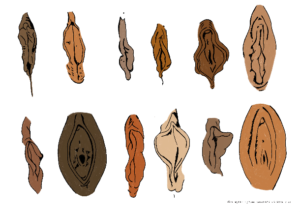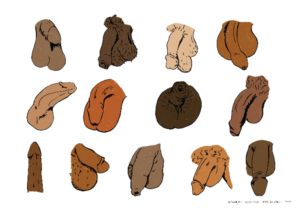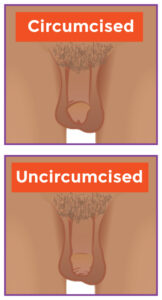Do you know the difference between a vulva and a vagina? What about the penis, foreskin and testicles? Does size matter? How much do you know about breasts? Have you ever checked your breasts?
This blog post was co-written by the International Student Health Hub team and Rainbow, an international medical student from Macau. Having been in Australia for nearly 4 years, Rainbow enjoys baking, listening to music and hiking and has always had an interest in discussing topics around mental health and sexual health.
Have you ever felt that your body parts look different from videos that you have watched or photos that you have seen? Let’s start by saying that we are all unique and beautiful. Everyone has differences in our body parts, so it is good to get to know what is normal for you.
In this blog we will get to know some body parts that are part of our sexual and reproductive anatomy:
- The vagina, vulva, labia and clitoris
- The penis and testicles
- Breasts
- The anus (bottom)
We hope you find this blog article helpful and learn something new about your body! There are some diagrams of body parts in this blog post. If you don’t feel comfortable looking at them, please close this screen now.
Section one: The vagina, vulva, labia and clitoris
Vagina and vulva
The vagina has become a popular umbrella term for female genitalia, but this body part is made up of many different parts.
The vagina is an internal organ. It is a strong muscular tube that is a passageway between the cervix (on the inside before the uterus/womb) and the vulva (on the outside). The vulva is what we see externally. The vulva includes the labia majora (the outer ‘lips’) and labia minora (the inner ‘lips’), the clitoris (the pleasure organ), the opening of the urethra (the hole where urine comes out) and the entrance of the vagina. An easy way to remember the difference, is that the vagina is inside the body and the vulva is outside.
The vagina has many functions:
- it allows menstrual blood and vaginal fluid to leave the body
- it is the way sperm enters the body to enable pregnancy
- it can be a site of sexual pleasure with penetration of a penis, sex toy or fingers.
The vagina has its own healthy bacteria that may prevent infections and bacterial overgrowths, like thrush. A healthy vagina will have a mild smell and discharge that will vary across the menstrual cycle. If you notice a different smell or if the colour of the discharge changes to something that is not normal for you, it is important to get a check-up with your doctor.
Fun Fact: The vagina is naturally self-cleaning. It doesn’t need douching or fragrant washes. The walls of the vagina are stretchy and produce fluid for lubrication and to clean itself.
Labia majora and labia minora
The labia majora are the outer lips covered in skin and grows pubic hair. The labia minora is the inner lips and are usually hairless. The labia minora are full of glands that keep them moist and soft. They can be different in size and shape, asymmetrical (unequal in size), and can hang outside the outer lips. It is not unusual for the labia minora to be longer than the labia majora.
Fun Fact: Labia are unique to each person. They come in different shapes and sizes.
Check out Sexual Health Quarter’s diagram of different body parts.

Clitoris
The clitoris contains more than 8, 000 to 10,000 nerve endings and is the only organ in the human body whose only purpose is sexual pleasure. It is very sensitive and is made of spongy tissue that swells with blood during sexual excitement. The external tip of the clitoris is found at the top of the vulva, above the urethra, where the inner lips meet.
Fun Fact: The clitoris never ages! An 80-year-old clitoris will look the same as a 20-year-old clitoris.
Check out Family Planning NSW’s diagram of different body parts.

Section two: The penis and testicles
Penis
Every penis is unique in shape, size and colour. The penis is used for urination (wee), reproduction and sexual pleasure. Sexual Health Quarters in Western Australia have made this diagram to show the different looks of penises.
Check out Sexual Health Quarter’s diagram of different body parts.

Foreskin
Some penises have a foreskin which covers and protects the glans at the head of the penis. For cultural or medical reasons, the foreskin is sometimes removed through a process called circumcision. Both penises with and without a foreskin are normal! Family Planning NSW’s diagram shows an example of what a circumcised and uncircumcised penis may look like.
Fun Fact: Foreskin length varies widely when the penis is flaccid (soft) or erect (hard).
Check out Family Planning’s diagram.

Testicles
For people who have a penis, they will find two circular spongy ball-shaped parts underneath the penis called the testicles. The testicles are located inside the scrotum. Some common slang names for testicles include balls, nuts and sack.
The testicles produce the hormone testosterone and are a place where sperm is produced and then later released during ejaculation via the vas deferens in the penis. You might hear ejaculation more commonly called cumming.
Fun Fact: Testicles are easily injured because they are not protected by muscle or bone.
Erections
An erection happens to the penis during sexual excitement. The penis fills with blood and becomes stiff and hard. The erection will go away, and the penis will soften after ejaculation or when sexual excitement has stopped.
Fun Fact: An erection can last anywhere from a few minutes to about half an hour.
If you have any questions about your penis or testicles, you can ask Nurse Nettie or talk to your doctor. Check out Family Planning’s diagram.

Section three: Breasts
Boobs, breasts, chest, nipples. There is no definition of the ‘normal’ size of breasts and lots of people have different size breasts. It is best not to make comparisons with others.
Here are some facts about breasts:
- everyone has breast tissue
- breasts are made up of tissue and fat and are located on the chest
- breasts can produce milk during and after pregnancy.
It’s important to know how your breasts usually look and feel so that if there are any changes, you can seek help as soon as possible. If you notice a lump in or around your breast and armpit, if you have any pain or skin changes in the breast area – seek medical advice from a GP. Unsure how to examine your breasts? Check out this page from Family Planning NSW for tips on how to be breast aware.
Fun Fact: Each breast has 15 to 20 sections, called lobes that are arranged like the petals of a daisy.
Section four: The anus (bottom)
The anus is sometimes called the bottom or bum hole. It’s the opening from the rectum located in-between the buttocks. It’s where our faeces (poo) comes out. The muscles around the anus assist in defecating (pooing) as well as holding it in.
Just like genitals, the anus is very sensitive and can be part of sex, called anal sex. Anal sex is when a penis, fingers or a sex toy is inserted into the anus during sex. It can range from touching the outside to inserting something into the anus.
With any type of sex, it is important to remember:
- consent is always needed. Read more about consent here.
- using condoms during sex prevents sexually transmissible infections (STIs) and HIV from being passed on. Find out how to use a condom correctly here.
- using water-based lube is recommended. Learn more about lube here.
Fun Fact: The peach emoji is used in texting to convey a butt.
Wrapping up
A theme we hope you have noticed in this blog post is that there is no ‘normal’ when it comes to body parts. Every person is unique and that is a beautiful thing about human bodies.
Although there is no universal ‘normal’, it is important to be familiar with what is normal for your body so that if something changes for example you notice a lump, change in colour, discharge or anything abnormal for you. You can seek medical advice from your GP or access the free online Nurse Nettie service.






